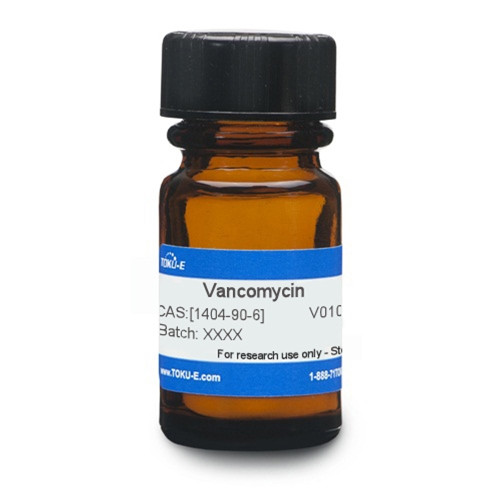Vancomycin is a glycopeptide antibiotic derived from Streptomyces orientalis that was discovered in 1953 from a soil sample found in Borneo. It is effective against gram-positive bacteria such as Staphylococcus aureus and is used in studies of nanoparticle transport and antibiotic resistance studies.
Vancomycin acts as a cell wall synthesis inhibitor in bacteria by preventing the transfer and addition of NAM/NAG-peptides that make up the peptidoglycan cell wall structure.
Vancomycin has low cell toxicity in plant cells and has been used in conjunction with Cefotaxime or Carbenicillin to stop the growth of Agrobacterium in plant cell culture and transformation.
We also offer:
- Vancomyin Hydrochloride, USP (V001)
- Vancomycin Hydrochloride, CulturePure® (V007)
- Vancomycin B Hydrochloride, EvoPure® (V008)
| Mechanism of Action | Vancomycin prevents cell wall synthesis by two separate mechanisms. One mechanism prevents N-acetylmuramic acid (NAM) and N-acetylglucosamine (NAG) peptides from linking together forming the peptidoglycan backbone through the incorporation of the Vancomycin molecule to the D-alanyl-D-alanine terminal. The second mechanism prevents crosslinking between amino acid residues in the peptidoglycan chain altering bacterial cell membrane permeability as well as RNA synthesis. |
| Spectrum | Vancomycin inhibits growth of many Gram-positive bacteria including the antibiotic resistant superbug, MRSA (Methicillin resistant Staphylococcus aureus). Vancomycin is effective for treating MRSA infections because it inhibits cell wall synthesis through a different mechanism other than β-lactam antibiotics. Over the years, Gram-positive bacteria have emerged that are resistant to Vancomycin, such as Vancomycin- resistant Staphylococcus aureus (VRSA) and Vancomycin-resistant enterococci (VRE). |
| Impurity Profile | Individual Impurity: Not more than 3.0% Related Substances: Not more than 7.0% Content of EDTA: Not more than 120 ppm |
| Microbiology Applications | Vancomycin inhibits the growth of most Gram-positive bacteria including the MRSA. It is usually only indicated for the treatment of serious or life-threatening bacterial infections like those caused by β-lactam-resistant staphylococci bacterial infections. There are now Vancomycin resistant bacteria, primarily, Vancomycin resistant Staphylococcus aureus (VRSA), and Vancomycin-resistant enterococci (VRE).
Vancomycin and Vancomycin Hydrochloride, USP are commonly used in selective media for isolation of Gram-negative pathogens including Campylobacter jejuni, Escherichia coli, Haemophilus influenzae, Helicobacter pylori, and Neisseria gonorrhoeae. See: superbug vancomycin resistant enterococcus (VRE) detection. Representative MIC values include:
Pryjma et al. used Vancomycin (TOKU-E) in Mueller Hinton (MH) medium to isolate Campylobacter jejuni: "FdhTU-modulated formate dehydrogenase expression and electron donor availability enhance recovery of Campylobacter jejuni following host cell infection" |
| Plant Biology Applications | Vancomycin has low toxicity to plant cells and is often used in Agrobacterium tumefaciens mediated transformation as a method to control its growth in plant cell culture media. Vancomycin is also suitable for bacterial contamination control in plant cell culture media and is sometimes used in combination with cefotaxime due to greater synergistic effects. Most studies do not describe any negative effects to the plant by using Vancomycin, however, in a study done by Silva and Fukai (2001), lower efficiency of transformation was found at concentrations of 500 µg/ml. |
| Eukaryotic Cell Culture Applications | Vancomycin can be used to select for cells containing the pcDNA3.1 resistance plasmid in 293 cell lines at an effective concentration of 400 µg/mL. For additional information on your cell culture needs, please visit our cell-culture database. |
| Molecular Formula | C66H75Cl2N9O24 |
| Assay | (As-Is): Not less than 850 µg/mg (Dried Basis): Not less than 950 µg/mg |
| References |
Courvalin P (2006) Vancomycin resistance in Gram-positive cocci. Clin. Infect. Dis. (2006): 25-34 Joshi S et al (2013) Methicillin resistant Staphylococcus aureus (MRSA) in India: Prevalence & susceptibility pattern. Indian J. Med. Res. 137(2):363-369 Pollock, HM, Holt J and Murray C (1983) Comparison of susceptibilities of anaerobic bacteria to cefemenoxime, ceftriaxone and other antimicrobial compounds. Antimicrob. Agents Chemother. 23: 780-783 Silva JA and Fukai S (2001) The impact of carbenicillin, cefotaxime and Vancomycin on chrysanthemum and tobacco TCL morphogenesis and Agrobacterium growth. J. Appl. Hort., 3(1):3-12 |







